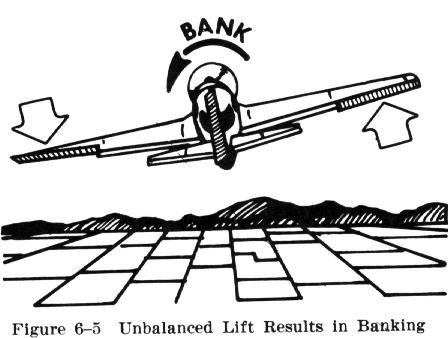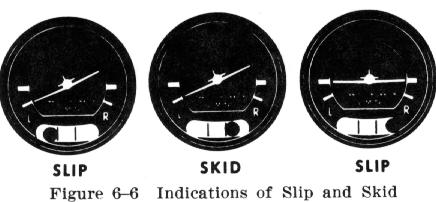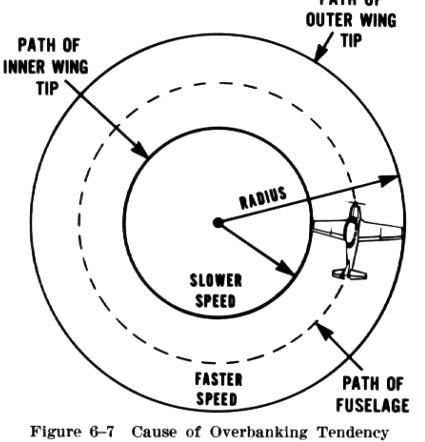Turns
Turns
A turn is a basic flight maneuver used to change or return
to the desired heading. It involves close coordination of all three flight
controls - aileron, rudder, and elevator. Since turns are a part of most
other flight maneuvers, it is important that the pilot thoroughly understand
factors involved and learn to perform them well.
For purposes of this discussion, turns are divided into
three classes: shallow, medium, and steep (Fig 6-4).
Shallow turns are those in which the bank is so shallow
(less than approximately 20 degrees) that the inherent stability of the
airplane is acting to level the wings unless some control force is used
to maintain the bank.
Medium turns are those resulting from a degree of bank
(approximately 20 to 45 degrees) at which the airplane tends to hold a
constant bank without control force on the ailerons.
Steep turns are those resulting from a degree of bank (more
than approximately 45 degrees) at which the "overbanking tendency" of an
airplane overcomes stability, and the bank tends to increase unless pressure
is applied to the aileron controls to prevent it. |
|
 |
The actual bank angle (degrees of bank) required for a given rate of
turn is a function of airspeed and airplane design.
As explained in the chapter Effect and Use of Controls, turns are made
in an airplane by banking the wings, so that by changing the direction
of the wing's lift toward one side or the other, the airplane will be pulled
in that direction. This is done by applying coordinated aileron and rudder
pressure to bank the airplane in the direction of the desired turn (Fig.
6-5).
It will be recalled that when an airplane is flying straight and level,
the total lift is acting perpendicular to the wings and to the earth. As
the airplane is banked into a turn, the lift then becomes the resultant
of two components. One, the vertical component, continues to act perpendicular
to the earth and opposes gravity. The other, the |
horizontal component, acts parallel to the earth's surface and opposes
centrifugal force caused by the turn. These two lift components act at
right angles to each other, causing the resultant lifting force to act
perpendicular to the banked wing of the airplane. It is this lifting force
that actually turns the airplane - not the rudder as misinformed pilots
might believe. The fallacy that the rudder makes the airplane turn was
demonstrated in the earlier explanation of the Effect and Use of Controls.
When applying aileron to bank the airplane, the depressed
or lowered aileron (on the rising wing) produces a greater drag than the
raised aileron (on the lowering wing). This increased aileron drag tends
to yaw the airplane toward the rising wing, or opposite to the desired
direction of turn, while the banking action is taking effect. To counteract
the yawing tendency, rudder pressure must be applied simultaneously in
the desired direction of turn. This produces a coordinated turn.
The adverse yaw produced by aileron drag has been a major
consideration in design of the controls, and in most modern airplanes has
been significantly reduced. This is accomplished by providing greater up
travel than down travel of the ailerons, or by using Frise type, or slotted
ailerons.
After the bank has been established, in a theoretically
perfect medium turn in smooth air, all pressure on the aileron control
may be relaxed. The airplane will remain at the bank selected with no further
tendency to yaw since there is no longer a deflection of the ailerons.
As a result, pressure may also be relaxed on the rudder pedals, and the
rudder allowed to streamline itself with the direction of the air passing
it.
| If pressure is maintained on the rudder after the turn
is established, the airplane will tend to skid to the outside of the turn.
If a definite effort is made to center the rudder rather than let it streamline
itself to the turn, it is probable that some opposite rudder pressure will
be exerted inadvertently. This would tend to force the airplane to yaw
opposite its original turning path. As a result the airplane would tend
to slip to the inside of the turn. The ball in the turn indicator will
be displaced off center whenever the airplane is skidding or slipping sidewards
(Fig. 6-6). |
 |
In all turns in which a constant altitude is to be maintained,
it is necessary to increase the angle of attack by applying back elevator
pressure. This is required because lift that is equal to the weight of
the airplane plus the centrifugal force caused by the turn must be obtained
from the wing to maintain altitude. Producing sufficient lift for the turn
could be done either by increasing the power and airspeed or by increasing
the angle of attack. The force of lift must be further increased as the
turn steepens and the load factor and the centrifugal force build up, but
must be slowly decreased as the airplane is being rolled back to level
flight when completing the turn.
To stop the turn, the wings must be returned to laterally
level flight by the use of the ailerons, and the resulting adverse yaw
(now acting in the same direction as the turn), must be overcome by the
coordinated application of rudder. The yaw effect will often be more apparent
when rolling out of a turn than rolling into a turn, due to the higher
angle of attack and wing loading, and the slower airspeed which exists
when the rollout is started. A greater deflection of the ailerons is necessary
to obtain the same control effect as when rolling into the turn from level
flight. Due to the slower airspeed, this displacement of the ailerons requires
less pressure on the aileron control, but it also imposes a greater drag
on the "down" aileron since the wing is at a greater angle of attack. The
greater drag on that aileron now tends to make the airplane yaw toward
the direction of the turn rather than away from it; therefore, a greater
rudder pressure must be used to counteract it.
To understand the relationship between airspeed, bank,
and radius of turn, it must be recalled that the rate of turn at any given
airspeed depends on the amount of the sideward force causing the turn;
that is, the horizontal lift component. The horizontal lift component varies
in proportion to the amount of bank. Thus, the rate of turn at a given
airspeed increases as the angle of bank is increased. On the other hand,
when a turn is made at a higher airspeed at a given bank angle, the inertia
is greater and the centrifugal force created by the turn becomes greater,
causing the turning rate to become slower. It can be seen, then, that at
a given angle of bank, a higher airspeed will make the radius of the turn
larger because the airplane will be turning at a slower rate.
With an airplane possessing positive lateral stability,
a wing which has lowered as the result of a gust of air will usually tend
to return to its original position. However, this inherent tendency should
not be depended on because other factors may overcome it. The pilot should
take appropriate control action to level the wing whenever necessary to
prevent the airplane from entering an unintentional spiral.
 |
Figure 6-7 illustrates the partial explanation of the airplane's overbanking
tendency during a steep turn. As the radius of the turn becomes smaller,
a significant difference develops between the speed of the inside wing
and the speed of the outside wing. The wing on the outside of the turn
travels a longer circuit than the inside wing, yet both complete their
respective circuits in the same length of time. Therefore, the outside
wing must travel faster than the inside wing and as a result it develops
more lift. This creates a slight differential between the lift of the inside
and outside wings and tends to further increase the bank.
When changing from a shallow bank to a medium bank, the airspeed of
the wing on the outside of the turn increases in relation to the inside
wing as the radius of turn decreases, but the force created exactly balances
the force of the inherent lateral stability of the airplane, so that at
a given speed, no aileron pressure is required to maintain that bank. However,
as the radius decreases further when the bank progresses from a medium
bank to a steep bank, the lift differential overbalances the lateral stability,
and counteractive pressure on the ailerons is necessary to keep the bank
from steepening. |
To establish the desired angle of bank, the pilot should use outside
visual reference points as well as specific indications on the attitude
indicator (Fig. 6-4).
The best outside reference for establishing the degree
of bank is the angle formed by the raised wing of low wing airplanes (the
lowered wing of high wing airplanes) and the horizon, or the angle made
by the top of the engine cowling and the horizon. Since on most light planes
the engine cowling is fairly flat, its horizontal angle to the horizon
will give some indication of the approximate degree of bank. Also, information
obtained from the attitude indicator will show the angle of the wing in
relation to the horizon.
The pilot's posture while seated in the airplane is very
important in all maneuvers, particularly during turns, since it will affect
the alignment of outside visual references. At the beginning the student
may lean to the side when rolling into the turn in an attempt to remain
upright in relation to the ground rather than "ride" with the airplane.
This tendency must be corrected at the outset, if the student is to learn
to properly use visual references.
This tendency is also characteristic in airplanes which
have side by side seats because the pilot is seated to one side of the
longitudinal axis about which the airplane rolls. This makes the nose appear
to rise when making a correct left turn and to descend in correct right
turns.
As in all maneuvering, the pilot should form the habit
of ensuring that the area toward which a turn is to be made is clear of
other aircraft. This is especially vital in high wing airplanes since once
the bank is started, the lowered wing may conceal other aircraft in that
direction. If nearby aircraft are not detected before lowering the wing,
it would be too late to avoid a collision.
After the area has been cleared, the turn should be started
by gradually and simultaneously applying pressure to both the aileron and
rudder in the desired direction. This pressure will move the control surfaces
out of their streamlined position and cause the airplane to bank and turn.
The rate at which the airplane rolls into the turn is governed by the rapidity
and amount of pressure applied.
When entering turns, pressure should be applied on the
ailerons and the rudder progressively; that is, applied smoothly, and gradually
built up, then gradually relaxed just before the desired degree of bank
is attained.
The rotation of the airplane about its longitudinal axis
when entering a turn should be accomplished in such manner that a pitch
attitude also may be maintained which will produce flight at a constant
altitude. Because of the decrease in the vertical lift component and the
increase in load factor in the turn, the angle of attack required to maintain
altitude will be slightly higher than in straight and level flight, if
no power adjustment is made. Consequently, sufficient back pressure must
be applied to the elevator control. The steeper the bank, of course, the
greater the increase in required angle of attack; therefore, more back
pressure is needed.
As soon as the airplane rolls from the wings level attitude,
the nose should also start to move along the horizon, increasing its rate
of travel proportionately as the bank is increased. Any variation from
this will be indicative of the particular control that is being misused.
The following variations provide excellent guides:
1. If the nose starts to move before
the bank starts, rudder is being applied too soon.
2. If the bank starts before the nose
starts turning, or the nose moves in the opposite direction, the rudder
is being used too late.
3. If the nose moves up or down when
entering a bank, excessive or insufficient back elevator pressure is being
applied.
As the desired angle of bank is established, aileron and
rudder pressures should be released. This will stop the bank from increasing,
for the aileron control surfaces will be neutral in their streamlined position.
The back elevator pressure should not be released but should be held constant
or sometimes increased to maintain a constant altitude. Throughout the
turn, the pilot should cross check the references and occasionally include
the altimeter to determine whether or not the pitch attitude is correct.
If gaining or losing altitude, the pitch attitude should be adjusted in
relation to the horizon and then the altimeter and vertical speed indicator
rechecked to determine if altitude is now being maintained.
During all turns, the ailerons and rudder are used to correct
minor variations just as they are in straight and level flight. However,
during very steep turns, considerably more back elevator pressure is required
to maintain altitude than in shallow and medium turns, and additional power
may be needed to maintain a safe airspeed. Frequently, there is a tendency
for the airplane's nose to lower, resulting in a loss of altitude.
To recover from an unintentional nose low attitude during
a steep turn, the pilot should first reduce the angle of bank with coordinated
aileron and rudder pressure. Then back elevator pressure should be used
to raise the airplane's nose to the desired pitch attitude. After accomplishing
this, the desired angle of bank can be reestablished. Attempting to raise
the nose first by increasing back elevator pressure will usually cause
a tight descending spiral, and could lead to overstressing the airplane.
The rollout from a turn is similar to the roll in except
that control pressures are used in the opposite direction. Aileron and
rudder pressure are applied in the direction of the rollout or toward the
high wing. As the angle of bank decreases, the elevator pressure should
be released smoothly as necessary to maintain altitude, since the airplane
is no longer banking and the effects of centrifugal force and the vertical
component of lift are becoming less.
Since the airplane will continue turning as long as there
is any bank, the rollout must be started before reaching the desired heading.
The amount required to lead the heading will depend on the rate of turn
and the rate at which the rollout will be made. As the wings become level,
the control pressures should be gradually and smoothly released so that
the controls are neutralized as the airplane assumes straight and level
flight. As the rollout is being completed, attention should be given to
outside visual references as well as the attitude indicator and heading
indicator to determine that the wings are being leveled precisely and the
turn stopped.
To make a precision 90 degree turn using outside references,
the airplane should be aligned with a road or section line on the ground
and then a turn made to where the airplane will be perpendicular to the
road or line. In the absence of any ground reference, a point may be selected
on the horizon directly off the wingtip, then the airplane turned until
it is headed to that point. The selection of the reference should be made
while visually scanning the area for other aircraft, obstacles, or nearby
clouds.



